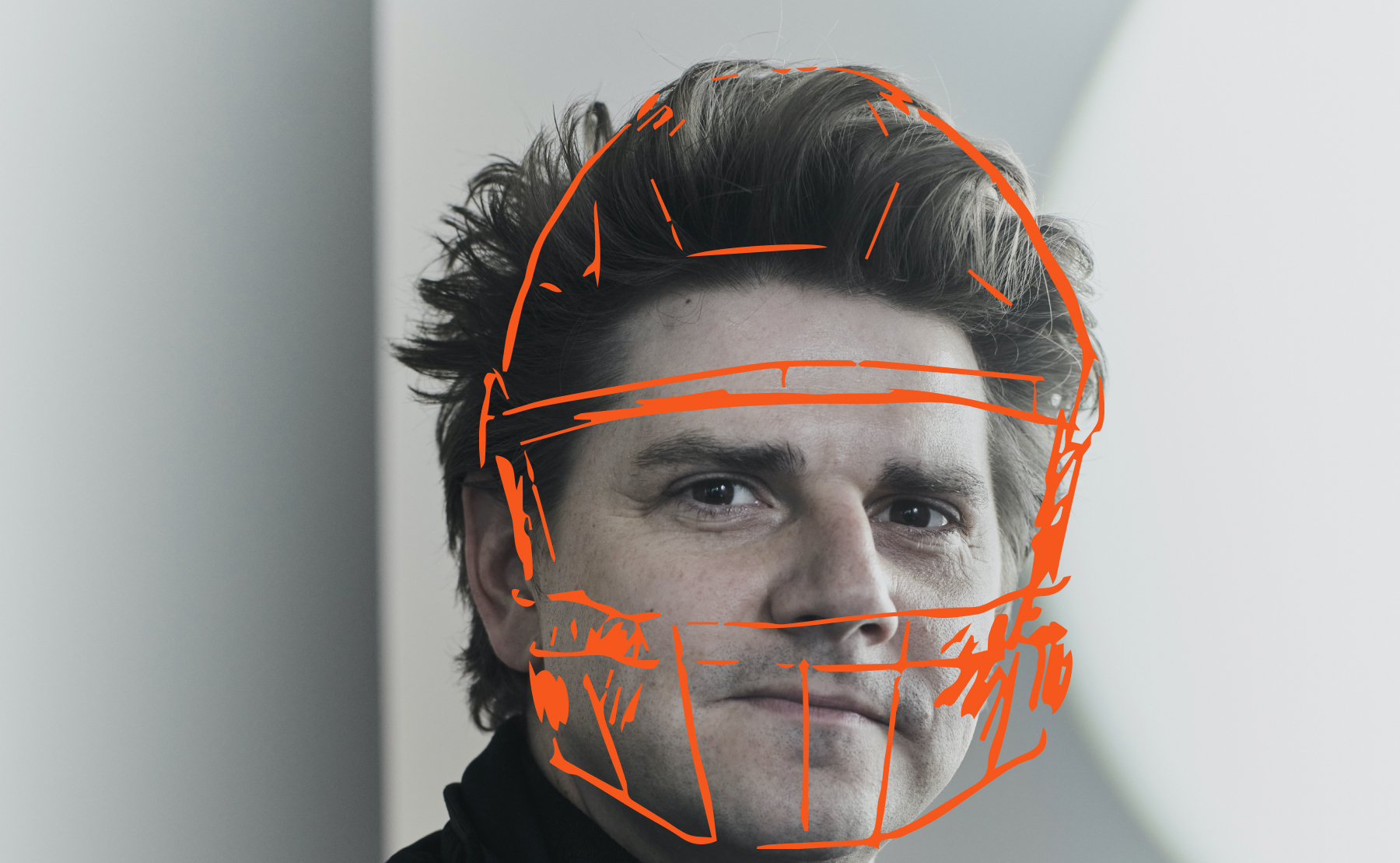Nick Fajt has a prescient view of how you will interact with tech in the future. No longer limited to flat screens and tiles, you will live in a world of augmented reality. You will wear smart glasses from dawn till dusk. When you are on the street, you will realize you are hungry and you will say, “Hey, I want some food.” Digital reviews will pop out of nearby restaurants. You’ll see that your friend loved the tandoori chicken at the Indian place around the corner. You’ll call that friend and chat with their hologram as it walks along with you to the restaurant.
Fajt sees this inevitable future with astonishing clarity. In fact, he’s had a vision of it ever since he was a child growing up in a suburb outside of Pittsburgh. But before he could begin building that future, he first had to convince his parents to get him a SEGA.
When he was around 13in the mid-’90s, Fajt asked his parents for the new $189 SEGA Genesis. Although generally supportive of the idea, they believed that when you really wanted something, you had to earn it. So he did his chores and squirreled away his allowance until he had saved enough money to buy it himself. His first game? Sonic the Hedgehog 2, which quickly became so much more than a game for him. “Playing side by side on the couch with friends in somebody’s basement was just such a huge part of how I socialized and interacted with other people, it was hard to imagine doing anything else,” Fajt says. The game helped him connect with his friends, and more than that, it was his first taste of a future he’d come to think of as inevitable.
In the parlance of sociologist Ray Oldenburg, the gaming system was Fajt’s “third place”—a space that is not your home and not your work, but rather a liminal space in between. It’s a place where people exchange ideas, relax and have a good time. Before the internet, that may have been a bowling alley, roller-skating rink or your local diner.
In today’s era, social interactions are delayed, asynchronous. Facebook, Instagram, Twitter—messages exist passively on the internet waiting for someone to see and respond. So where is today’s digital third place? That’s what hooked Fajt as a teenager playing video games—he’d found a place where gaming and community intersect. That’s what was on his mind when he launched Rec Room in 2016: He wanted to build a place where you can hang out, have fun and play games with people all over the world (or next door).
Get the best stories from the Sequoia community.
“Gaming now doesn’t just mean playing games. It means a virtual world.”
NICK FAJT
Like other red-blooded Western Pennsylivanians, Fajt’s family were die-hard Penn State lovers—both of his parents and his sisters had gone to the Big Ten school, and he grew up sitting in the stands during college football games. So his parents were a little dismayed when they learned that Fajt had his sights set on the prestigious computer science program at Cornell University, but got on board as it became clear how happy it made their son. “My very first CS class freshman year, I was like, this is amazing,” Fajt remembers. He also remembers that it didn’t take long to realize that he wasn’t a coding prodigy, but his CS courses taught him to “communicate well with developers. I decided not to become a developer myself, but more of an organizer, a program manager. I was happy to find a role that tolerated my lack of knowledge and skill, but let me stay close to that thing that I really loved.”
He got even closer the summer after his sophomore year, scoring an internship at Microsoft that he parlayed into a full-time job after he graduated in 2009. His first assignment was to manage the downloadable content for Forza Motorsport, an Xbox racing game, an aspect of the game that was social and involved user-generated content, creating car designs that they could sell to other players. Then, in 2012 he began working on developing games for a new device code-named Gravity. Here, finally, was a glimpse of that future he knew was waiting for him.
Gravity was an augmented-reality (AR) device that would later be known as HoloLens. The creative director on the team was Cam Brown, a 26-year veteran of game design, who hailed from Australia and worked on “shoot-em-up” games for years before leading the Gravity team. Brown, like Fajt, was ready for the future, and in 2012 that future was AR. Yet for all its promise, the HoloLens device was bulky, prohibitively expensive, and had another major flaw: It didn’t really work.
Brown knew that in game development, 99 times out of 100, the problem was in the software. Not so with the HoloLens: “Parts would be melting off and wires would be flying off,” Brown says. “Behind the scenes, it was just absolute chaos. We would get out in front of 2,000 people and we would put on this demo and be like, ‘Please work. Please work.’ And so we just put in a lot of hours of high-stakes, high-stress, demo-focused work.”
Brown remembers wearing a headpiece during demos that looked like it was made by Doc Brown from Back to the Future. It was also connected to a server about the size of a small refrigerator and an onion loaf of wires. Still, when it did work, crowds ate it up—and they loved Fajt’s easygoing expressiveness while he performed the demos, almost as if being tethered to a mess of wires, with screens in front of his eyes and haptic feedback devices in hand was his natural state. Once, Brown’s wife came to see their presentation. “It’s like he’s from the future,” she said to her husband.
Eventually, HoloLens went enterprise, pivoting to market its hardware exclusively for military applications. Fajt and the rest of the Gravity team were reorged across Microsoft. Assigned to work on the company’s newest browser, Edge, Fajt found himself further from his dream than when he started. And he wasn’t alone in that feeling; many former Gravity team members began leaving Microsoft to explore launching their own gaming companies.
In the winter of 2016, Fajt decided to do the same, assembling a team of former Microsoft co-workers to launch their own gaming company, and after nearly eight years at Microsoft, he knew exactly whom to call. There was his former boss, Cameron Brown, who knew everything it took to build a fantastic game. Then there was Dan Kroyman, he understood the social aspects of gameplay and how to build a game’s back end. Bilal Orhan was the team’s friendly neighborhood troll, instantly capable of manipulating a game and the people who played it. John Bevis was a game-player incarnate, an obsessive when it came to paddle, disc and gun games. And finally, there was Josh Wehrly, master at navigating a system, building engaging gameplay and creating “juicy interactions.”
The six of them felt in their bones that they were the right team for a new project, despite having never run their own company. “I think it’s just very difficult to assemble a team that’s capable of building a full product,” says Fajt. “But there was a high level of trust that we were bringing into the relationship. And we had all of the tool sets. We had all the skills to go and build a thing from day one.” The code name for HoloLens was Gravity, so as an inside joke they called the new enterprise Against Gravity.
Together, this core of six game developers built their first game in just under 100 days.
“I was happy to find a role that tolerated my lack of knowledge and skill, but let me stay close to that thing that I really loved.”
NICK FAJT

Rec Room began in the living room of Brown’s Seattle home. The six of them (plus two dander-shedding cats) hung out there for months on end, trying to whittle down their thoughts and premises. The cats would give Fajt minutes-long sneezing fits, forcing him to take handfuls of antihistamines until he was barely able to stay awake. But they had a limited amount of time to make something before they ran out of money and had to give up and find new jobs. So, dander be damned, they all kept focus.
HoloLens was one of the closest AR devices to the consumer market, but the team quickly realized that even that was nowhere close to its debut. Fortunately, HTC, another headset maker, was willing to give them a virtual reality device called Vive. They had their hardware, so now they needed to make their software.
Seeking a cat-free environment, the team soon moved to a WeWork in Seattle, all six sharing less than 100 square feet, constantly punching each other while demo-ing software on the Vive headsets. Meanwhile, Fajt was pounding the pavement to find seed money. There was barely a pitch deck, but they had friends in high, nerdy places, and, more important, a virtual reality game that promised to be fun.
In the spring of 2016, Fajt sent the game to dozens of prospective investors around the country. He preferred to pitch investors while they were in-game—all sitting around a virtual table in a conference room with graphs and slides surrounding them. Some liked this unique pitching technique, some didn’t. Stephanie Zhan, partner at Sequoia Capital, did.
Zhan was having a casual dinner with other investors when a friend at a Seattle-based fund mentioned Rec Room. Weeks later, she entered a room with a glass door at the Sequoia offices affectionately called the “fishbowl,” where partners can test out various AR and VR devices. She put on the headset and logged on to Rec Room.
“What I liked about this feeling and environment was, it had a very distinct art style. You knew what this environment was about. There was a clear kind of storyline and setting,” Zhan says. She, like Fajt, was looking to see “how we extend these third places to make spaces that are fun, playful and light—turning passive forms of entertainment into more active forms of entertainment.” Rec Room had that in spades.
On June 1, 2016, Rec Room was released to the public, a new game on a new device with no market research for how well it would do. “The feeling was very much like throwing a party,” says Brown. “That feeling like, ‘All right. We sent the invite. We’re expecting people to come around at 6 p.m.,’ but the doorbell hasn’t rung yet.”
Brown (Gribbly, as he is known on Rec Room) spent most of those first days chatting with players in Texas and France and the United Kingdom, showing off their first six games—a collection of “Wii Sports for VR” games that included paintball, disc golf and paddleball. Fajt and the team were very specific about how they wanted to approach their game, and it showed. When Zhan first tried it out, she noted, “You could feel the physics, and it was really good.” Rec Room soon rose to the top of Steam’s VR game rankings. The only problem? VR itself.
Everyone thought that VR was the next thing in technology, but in late 2016 it was still too expensive on the consumer end, and those cords still tethered the user. Rec Room couldn’t grow unless they cut them, so to speak.
On the developer end, game designers would usually get new consoles a year or more in advance, allowing them to create new games that work smoothly with the new tech. But nothing was being sent down the line. “We could see the hardware horizon, … and we were just not receiving any hardware,” Fajt said. He knew that Rec Room could be the big fish in the small, existing VR pond, but with seemingly no new hardware in the pipeline, was it sustainable?
Cost and runway were always on Fajt’s mind, as was potential for growth. “If the product shuts down and the company runs out of money, no one’s well served there. It was a very logical step by step, what is going to happen in the long term if we ignore this,” he says. He could see VR’s emergent existential crisis starting to weigh heavily on the community of users, almost as much as it was weighing on his own team. “It was challenging,” says Fajt, “probably one of the more challenging pivots that we’ve ever done. But I’m very happy that we did it.”
Within three years, Fajt would open the door to a flat world (a traditional, non-VR screen), but this wouldn’t be an entirely separate game; it would be a larger one.
“We got here iteratively with very tiny steps.”
NICK FAJT
In the summer of 2019, Rec Room launched on PlayStation, much to the dismay of many of their still-loyal VR fans, who didn’t want their gaming experience destroyed by “flat screeners.” And Fajt could have done that. He could have given up entirely on VR like so many others had, but instead he kept a VR version of the game, and added consoles, then PCs and even mobile. He still had his vision for the future clearly in mind, and he knew that VR, or something like it, would play a major role in that future. He was ready to play the long game, but opening the software up to other devices allowed Rec Room to grow and continue to build an online community while the rest of the world caught up to his vision. Rec Room could be for everyone and anyone. Within months, the community began to accept it, encourage it, and even started to relish not having to strap in to play.
Gradually, the community began outgrowing those rooms. Instead of shooting paintballs, slinging discs, and launching grenades, users would meet in the paintball ring and just sit and chat. They would go to the disc golf course, but instead of throwing discs, they would go on walks to the edge of the game. They started creating new games out of what was already there.
Tamara Hughes, known as Mamamonkey on Rec Room, was one of those innovators. “Everybody was sort of in on it, making up games with their own rules. We did Sardines, Ultimate Frisbee,” she remembers. At the time, the Discord channel was small enough that players like Hughes could message Rec Room developers directly and ask them to put a frisbee in, say, the soccer room so that large groups could gather to play. The developers were happy to oblige. After a while, Fajt took note of Hughes’s ability to gather people together and occasionally “break” the game. His response? Hire her.
Excited by what he saw from Hughes and players like her, Fajt decided that if users wanted their own games, Rec Room would empower them to build them. Suddenly, Rec Room morphed into something new, a virtual world where everyone could make their own rooms, where they could hold family reunions, company retreats, even weddings—and they did. By the end of 2019, Rec Room had around 100,000 active users each day.
Fajt and his team kept creating games in Rec Room—everything from quest games with titles like Crescendo of the Blood Moon, to classic bowling games—but only to show the community what they could do. Each update gave users more freedom to create user-generated content, but sometimes the jump was too much, and users would get confused. After all, how do you encourage someone without any formal game design experience to create a game, a room, a world?
For the most part, the community has been kind to the developers, understanding that they are creating this world together, and any act of creation has growing pains. Today, Rec Room is a cross-platform metaverse with a $1.25 billion valuation. But even as they’ve grown, Nick and his team understand that if the customers stop showing up, you can’t restart the game. And so they’ve learned to react without being reactionary, evolving their world as they evolve their own understanding of what that world can be.
Break their game? They let you make your own. You want to be able to return to the same room after logging out? They’ll let you come back as many times as you want. Bring your friends and your aunt as well. Fajt doesn’t always give users exactly what they want, but he gives them what they need—the tools to make it a third space straight out of their imagination.
As the pandemic raged across the globe and made IRL gathering hazardous, Rec Room became a place that people could continue to explore, and spend time with their loved ones; an opportunity to discover new frontiers when so many of our worlds shrank to the size of our homes. There were family reunions and weddings and even group therapy sessions. For better or for worse, as life has begun to open up again, Fajt believes “a whole bunch of behaviors have changed permanently.”
How we think about gaming has completely changed the consumer internet. “I think gaming now, what that term means, doesn’t just mean playing games. It means a virtual world. And in that virtual world I can be going on a date at a concert, I could be socializing with friends, I can be creating a space. I think you’re seeing gaming expand into fashion and music and creativity. Just so many new territories. Gaming no longer has such a narrow definition,” says Fajt. With that new definition, Fajt is hoping that as the next generation grows up in this increasingly virtual world, we will start assigning less value to things or objects, and more to concepts, creativity and ideas.
Through it all, a pivot and a pandemic, Fajt believes that Rec Room’s scrappiness has kept them afloat. “We got here iteratively with very tiny steps,” he says. Still, Fajt is looking 20 years down the road, when these tiny steps will let him take those actual steps on an augmented reality walk with friends.



